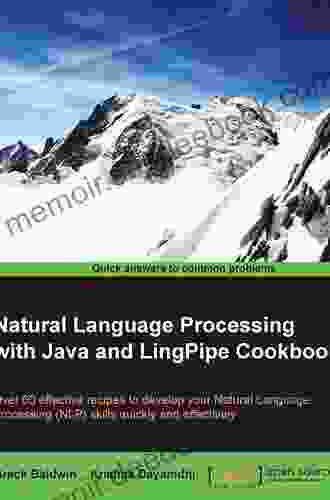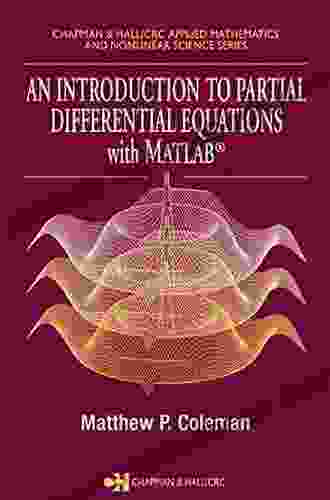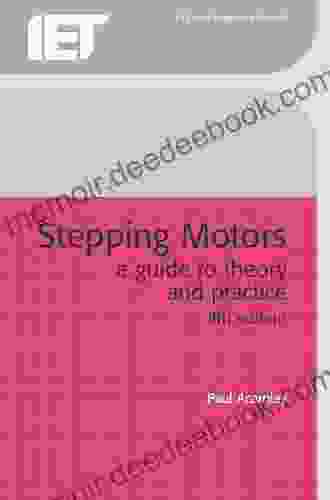An In-Depth Exploration of Partial Differential Equations with MATLAB®

Partial differential equations (PDEs) are mathematical equations that describe how a function or set of functions change with respect to multiple independent variables. They are widely used in various scientific and engineering disciplines, such as fluid mechanics, heat transfer, and electromagnetism.
4.4 out of 5
| Language | : | English |
| File size | : | 15009 KB |
| Screen Reader | : | Supported |
| Print length | : | 683 pages |
This article provides an to partial differential equations, with a focus on their solution using MATLAB®. We will cover the basics of PDEs, including classification, types, and applications. We will also explore the fundamentals of solving PDEs numerically using MATLAB®.
Classification of Partial Differential Equations
PDEs are classified based on their order, which refers to the highest derivative present in the equation. The order of a PDE determines the number of initial or boundary conditions required to solve the equation.
- First-order PDEs: These equations involve first-order derivatives of the unknown function. They can be linear or nonlinear.
- Second-order PDEs: These equations involve second-order derivatives of the unknown function. They are further classified into elliptic, parabolic, and hyperbolic equations based on their characteristics.
- Higher-order PDEs: These equations involve derivatives of order greater than two.
Types of Partial Differential Equations
There are various types of PDEs based on their mathematical form and applications.
- Linear PDEs: These equations have coefficients that are constant or functions of the independent variables only. They can be solved using analytical methods or numerical techniques.
- Nonlinear PDEs: These equations have coefficients that depend on the unknown function or its derivatives. They are more challenging to solve and often require numerical methods.
- Homogeneous PDEs: These equations have no constant or inhomogeneous terms. Their solutions are typically easier to obtain than those of inhomogeneous PDEs.
- Inhomogeneous PDEs: These equations have constant or inhomogeneous terms. Their solutions require additional boundary or initial conditions.
Applications of Partial Differential Equations
PDEs are used in a wide range of applications, including:
- Fluid mechanics: Modeling fluid flow and heat transfer in pipes, channels, and around objects.
- Heat transfer: Modeling the conduction, convection, and radiation of heat in solids, liquids, and gases.
- Electromagnetism: Modeling the propagation of electromagnetic waves in various materials.
- Solid mechanics: Modeling the deformation and stress in solids under load.
- Mathematical biology: Modeling population dynamics, enzyme kinetics, and other biological processes.
Solving Partial Differential Equations with MATLAB®
MATLAB® is a powerful software for numerical computing and visualization. It provides various functions and toolboxes for solving PDEs.
The following steps outline the general approach to solving PDEs using MATLAB®:
- Define the PDE: Specify the mathematical equation of the PDE, including the unknown function, independent variables, and any coefficients.
- Discretize the PDE: Convert the continuous PDE into a discrete system of equations using finite difference, finite element, or other numerical methods.
- Solve the discretized system: Use MATLAB® functions such as `solve` or `eig` to solve the system of equations.
- Visualize the solution: Plot or visualize the solution of the PDE using MATLAB® functions such as `surf` or `contourf`.
MATLAB® offers various toolboxes specifically designed for solving PDEs, such as the Partial Differential Equation Toolbox and the Finite Element Method Toolbox. These toolboxes provide a range of functions and pre-built solvers tailored to different types of PDEs.
Partial differential equations are essential mathematical tools used in various scientific and engineering disciplines. They describe the behavior of complex systems and processes involving multiple variables. Solving PDEs numerically using MATLAB® allows us to obtain approximate solutions to these equations and gain insights into the behavior of the underlying systems.
This provides a foundation for understanding and solving PDEs using MATLAB®. Further exploration and study are recommended to delve deeper into the subject and tackle more complex PDEs encountered in real-world applications.
References
- Quarteroni, A., & Valli, A. (2008). Numerical approximation of partial differential equations. Springer Science & Business Media.
- Smith, G. D. (2010). Numerical solution of partial differential equations: finite difference methods. Oxford University Press.
- MATLAB® Documentation: https://www.mathworks.com/help/pde/index.html
4.4 out of 5
| Language | : | English |
| File size | : | 15009 KB |
| Screen Reader | : | Supported |
| Print length | : | 683 pages |
Do you want to contribute by writing guest posts on this blog?
Please contact us and send us a resume of previous articles that you have written.
 Book
Book Page
Page Story
Story Reader
Reader Library
Library Paperback
Paperback E-book
E-book Magazine
Magazine Newspaper
Newspaper Bookmark
Bookmark Shelf
Shelf Glossary
Glossary Preface
Preface Synopsis
Synopsis Annotation
Annotation Footnote
Footnote Manuscript
Manuscript Codex
Codex Tome
Tome Bestseller
Bestseller Library card
Library card Narrative
Narrative Biography
Biography Narrator
Narrator Character
Character Resolution
Resolution Librarian
Librarian Catalog
Catalog Archives
Archives Periodicals
Periodicals Lending
Lending Reserve
Reserve Reading Room
Reading Room Rare Books
Rare Books Special Collections
Special Collections Literacy
Literacy Thesis
Thesis Dissertation
Dissertation Reading List
Reading List Textbooks
Textbooks Nahoko Uehashi
Nahoko Uehashi David Hernandez
David Hernandez Gail Collins
Gail Collins Alfred Delvau
Alfred Delvau Brendan Bruce
Brendan Bruce Christy Mihaly
Christy Mihaly John R Erickson
John R Erickson Stephanie Pokorny
Stephanie Pokorny Raymond Queneau
Raymond Queneau Park Cannon
Park Cannon Alice Clayton
Alice Clayton Kevin P Sheridan
Kevin P Sheridan Anna Yen
Anna Yen Diane A Ladley
Diane A Ladley Diana Taylor
Diana Taylor Kathryn Hughes
Kathryn Hughes Max Caulfield
Max Caulfield Kelly Hawkins
Kelly Hawkins Paolo Castelnuovo
Paolo Castelnuovo Warren Larsen
Warren Larsen
Light bulbAdvertise smarter! Our strategic ad space ensures maximum exposure. Reserve your spot today!
 Jermaine PowellFollow ·19.9k
Jermaine PowellFollow ·19.9k Jay SimmonsFollow ·7.4k
Jay SimmonsFollow ·7.4k Avery SimmonsFollow ·19k
Avery SimmonsFollow ·19k Eugene ScottFollow ·5k
Eugene ScottFollow ·5k John KeatsFollow ·3.7k
John KeatsFollow ·3.7k Junichiro TanizakiFollow ·10k
Junichiro TanizakiFollow ·10k Milton BellFollow ·5k
Milton BellFollow ·5k Enrique BlairFollow ·15.6k
Enrique BlairFollow ·15.6k

 Vernon Blair
Vernon BlairHow to Get a Woman to Pay for You: A Comprehensive Guide...
In the modern dating...

 Levi Powell
Levi PowellPrinciples and Theory for Data Mining and Machine...
Data mining and machine learning are two...

 Andrew Bell
Andrew BellMirrors For The Mind: Milestones In Discovery And...
Mirrors have been a part of human history...

 Alec Hayes
Alec HayesDelving into Natural Language Processing with Java and...
Natural Language Processing (NLP) is an...
4.4 out of 5
| Language | : | English |
| File size | : | 15009 KB |
| Screen Reader | : | Supported |
| Print length | : | 683 pages |
















